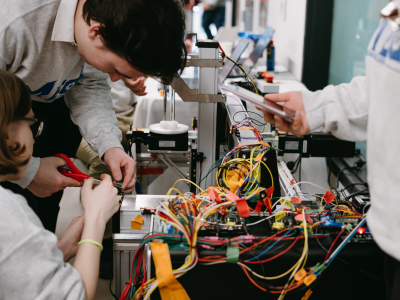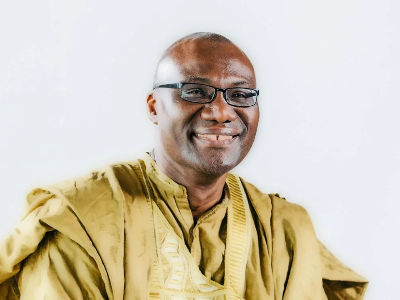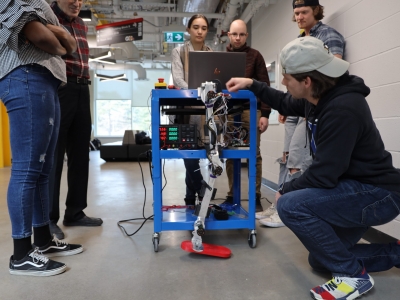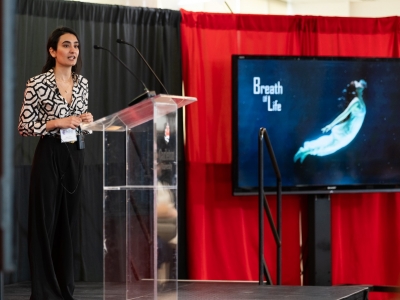
Carleton graduate Chad Harber (BID/07), Lead Industrial Designer at Fitbit, recently returned to Carleton to speak with students.
In 2007, on the advice of Carleton Prof. Bjarki Hallgrimsson, Chad Harber (BID/07) took his design portfolio and headed to San Francisco for the annual Connecting Conference. He’d planned to attend some seminars, portfolio reviews, studio tours and take advantage of some networking opportunities. What he didn’t expect was that he’d fall in in love with the local design industry. After the conference he sent a few followup e-mails—and just a few months later, Chad got a job offer from New Deal, a San Francisco-based design agency. Chad has remained in the Bay Area and has applied his ID skills to an agency, a startup and now the fitness technology leader Fitbit.
During his recent return to Carleton, we had the chance to speak with Chad about the value of industry networking, the pros and cons of different career paths, and why sometimes there’s no place like home.
Carleton University – Having established a successful career in California, what’s it like returning to campus (and to Ottawa)?
Chad Harber – It feels so good to be back at Carleton! I haven’t been back in nearly ten years. It is incredible to see how much the campus has evolved and improved over the past few years. You picture it a certain way in your memory and then you come back with wiser eyes and see things you never noticed before. Some things stay the same too. It’s good to see that the one brick in the Mackenzie building that was replaced by an Industrial Design (I.D.) student many years ago with a material called Renshape is still intact. A wave of nostalgia washed over me as I re-entered the halls of the architecture building, navigating its Escher like halls and stairs as I’ve I never left. Seeing a sleeping bag in the 2nd story tunnel that connects the I.D. and Architecture building brought back repressed memories of all-nighters. It’s also great to be back in Ottawa and Canada. While I don’t miss these winters, I do miss the dramatic seasonal changes we get in Ottawa compared to California.
CU – What do you hope to accomplish in coming back to speak with the current students?
CH – My main goal is to share as much as possible with the students that I have learned in time since I graduated. I’ve been working for 10 years now and I’ve been fortunate to work at a design agency, start-up and a now a corporate design team. I hope to share insights from working at these very different design environments as well as providing guidance when choosing which path to pursue. I will also reflect on my time at Carleton and share experiences on how to make the most of your time at school.
CU – Why is it important for students to have opportunities to engage with industry?
CH – As a student you can get caught up with academics and the structure of the education process. This is a good thing. However, it’s important to connect with people who are practicing what you are being taught so you can see how the education translates to different applications. With Industrial Design there are so many different ways to apply the education. I’ve taken a very traditional approach, but many of many of my classmates have gone into film, fashion, art and software to name a few. The process of industrial design can be applied to many career paths and it’s constantly evolving, this is another reason it’s important to stay connected to the state of the art. Finally, it wasn’t until I met a fellow Carleton grad working in San Francisco at a top design agency that I truly realized this was something I could do myself. Sometimes you need help to visualize your goals.
CU – In your opinion, what kinds of things are vital to creating an engaging student experience?
CH – Students want to connect with things they recognize from popular culture and relevant points of reference. With industrial design, they want to see really cool objects that they’ve seen on the web or in magazines—in other words, products they relate to. They also want to know the behind the scenes stories about how they were made and conceived. Personally, I think this is the best way to learn how to design, by seeing how other designers navigate the process and witnessing the story unfold. This isn’t always possible as most projects are shrouded in secrecy and confidentiality, but after a product has shipped, the story is sometimes public. Seeing the fragile ideas and rough mock-ups that lead to the polished final design is always humbling to anyone in design.
CU – What steps can students take to ensure they will have the skills that are in demand when they graduate?
CH – The I.D. program at Carleton has a great internship program. I would encourage at least a year of internships. The students that do this always yield greater success in 4th year. These skills and experiences also make it easier to land a job when you graduate. If you do really well during your internship you will have a job waiting for you when you get your diploma. I would highly recommend knowing how you would like to apply your education after you finish school. Knowing where you would like to work can really help get the most out of your education and ensure you are groomed well for the type of design work you wish to practice. This way you can do the research necessary to make sure you possess the skill needed when you are applying for your first post graduate employment.



